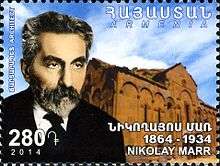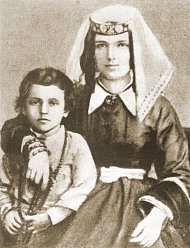Nicholas Marr

Nicholas Yakovlevich Marr (Russian: Никола́й Я́ковлевич Марр, Nikolay Yakovlevich Marr; Georgian: ნიკოლოზ იაკობის ძე მარი, Nikoloz Iak'obis dze Mari; 6 January 1865 [O.S. 25 December 1864] – 20 December 1934) was a Georgia-born historian and linguist who gained a reputation as a scholar of the Caucasus during the 1910s before embarking on his "Japhetic theory" on the origin of language (from 1924), now considered as pseudo-scientific,[1] and related speculative linguistic hypotheses.
Marr's hypotheses were used as a rationale in the campaign during the 1920–30s in the Soviet Union of introduction of Latin alphabets for smaller ethnicities of the country. In 1950, the "Japhetic theory" fell from official favour, with Joseph Stalin denouncing it as anti-Marxist.
Biography

Marr was born in Kutaisi, Georgia (then part of the Russian Empire), in the family of the Scot James Murray (phonetically adapted: Marr) (aged 71[2]) who founded the botanical garden of the city, and a young Georgian woman (Agrafina Magularia). His parents spoke different languages, and neither of them understood Russian. Having graduated from the St Petersburg University, he taught there beginning in 1891, becoming dean of the Oriental faculty in 1911 and member of the Russian Academy of Sciences in 1912. Between 1904 and 1917 he undertook yearly excavations at the ancient Armenian capital of Ani.[3]
He died in Leningrad.
Japhetic theory
Marr earned a reputation as a maverick genius with his Japhetic theory, postulating the common origin of Caucasian, Semitic-Hamitic, and Basque languages. In 1924, he went even further and proclaimed that all the languages of the world descended from a single proto-language which had consisted of four "diffused exclamations": sal, ber, yon, rosh. Although the languages undergo certain stages of development, his method of linguistic paleontology claims to make it possible to discern elements of primordial exclamations in any given language. One of his followers was Valerian Borisovich Aptekar, and one of his opponents was Arnold Chikobava.
Bibliography
Selected publications:
- Nikolai Yakovlevich Marr, Vardan (Aygektsi) (1899). Collections of proverbs Vartan: Izslѣdovanіe. Type. Imp. akademii Sciences.
- Nikolai Yakovlevich Marr (1910). Chanskago Grammar. Type. imp. Akademіi Sciences. p. 240.
- Jah Gato , Nikolai Yakovlevich Marr (1932). Amran. The Academy. p. 162.
- Nikolai Yakovlevich Marr (1932). Tristan and Isolda: love of the heroine of feudal Europe to the matriarchal goddess Afrevrazii. Publishing House of the Academy of Sciences of the USSR. p. 286.
- Nikolai Yakovlevich Marr, Valerian Borisovich Aptekar (1934). Language and Society. State Academy of the History of Material Culture.
- Nikolay Yakovlevich Marr, Valerian Borisovich Aptekar (1936). Collected articles. Power to the Soviets. p. 207.
- Nikolai Yakovlevich Marr (1940). Description of the Georgian manuscripts of Sinai Monastery. Publishing House of the Academy of Sciences of the USSR. p. 276.
References
- ↑ See e.g. В.М.Алпатов "Марр, марризм и сталинизм"
- ↑ "Nikolai Marr - a talk by Donald Rayfield 17 February". British Georgian Society. Retrieved 6 October 2015.
- ↑ Marr, Nicolas (2001). Ani - Rêve d'Arménie. Anagramme Editions. ISBN 978-2-914571-00-5.
Further reading
- Nicholas Yacolevich Marr 2001. Ani (with forewords by Jean-Pierre Kibarian and Parouyr Mouradi), Anagramme Ed.(Paris), (reprint).
- Ekaterina Velmezova 2007. Les lois du sens: la sémantique marriste. Bern: Peter Lang, 2007 — (Slavica Helvetica 77) — ISBN 978-3-03911-208-1.
External links
| Wikimedia Commons has media related to Nicholas Marr. |